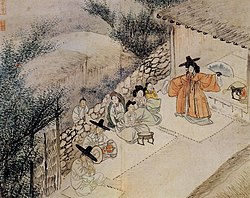| "Movement to overthrow superstition" | |
 "Village devil posts", jangseung as described in The passing of Korea (1906) by the American Protestant missionary Homer Bezaleel Hulbert. | |
| Korean name | |
|---|---|
| Hangul | 미신 타파 운동 |
| Hanja | 迷信打破運動 |
| Revised Romanization | Misin tapa undong |
| McCune–Reischauer | Misin t'ap'a undong |
| Part of a series on |
| Korean shamanism |
|---|
 |
In the history of modern and contemporary Korea, especially between the late 19th century and the 1980s, there have been a series of waves of movement to eliminate indigenous shamanism and folk religions.[1] In Korean, the movement is called misin tapa undong (Korean: 미신 타파 운동; Hanja: 迷信打破運動; lit. movement to overthrow superstition), regarding homegrown shamanism and anything related to it as "superstition" (미신; 迷信; misin); the modern Korean word for "superstition" also has the meaning of "illusory" or "false spiritual beliefs", and implies that gods and ancestors do not exist. This term was adopted from Japanese in the late 19th century, and largely emphasized by Christian missionaries to target Korean indigenous religion.[2]
Waves of the anti-shamanism movement started in the 1890s with the rise of influence of Protestant preachers in Korea,[1] culminating during the New Community Movement of the 20th century, in South Korea. These movements destroyed most of the indigenous cults and shrines of folk religion, which were largely replaced by Christianity.[3]
- ^ a b Kendall (2010), pp. 4–7.
- ^ Connor & Samuel (2001), pp. 28–29.
- ^ Kendall (2010), p. 10.
